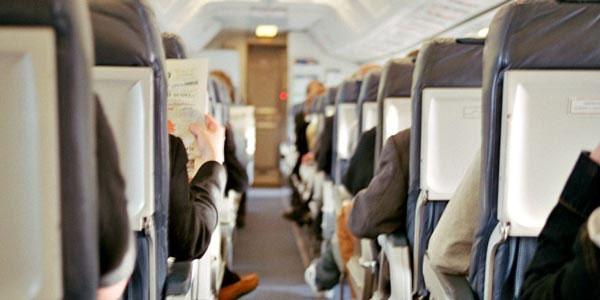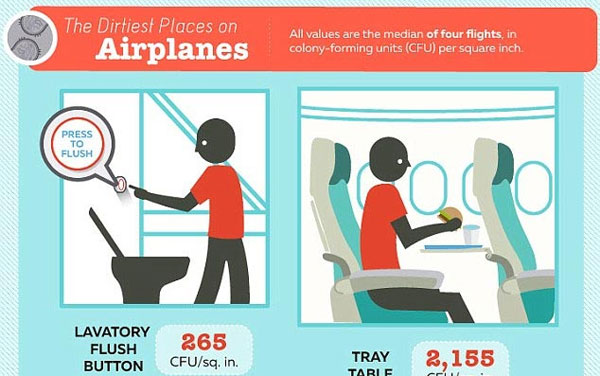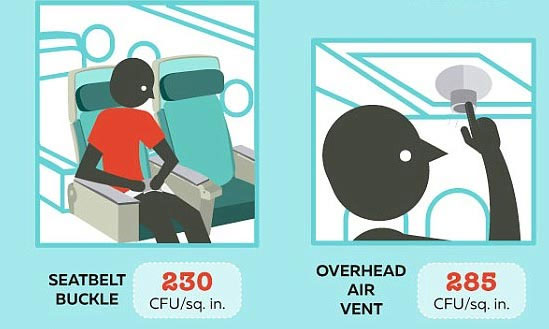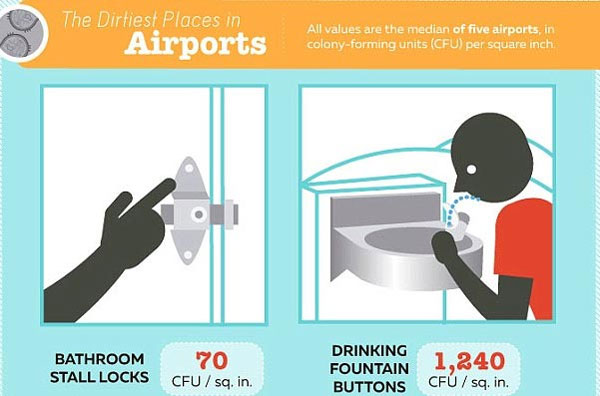The dirtiest place inside a plane is not a toilet
Bacteria lurk everywhere, from hidden corners of the house, your desk to public places like elevators or airports . And contrary to the common thinking of most of us, toilets are not the dirtiest place and contain the most pathogens on the plane, according to a new study.
Microbiological experts took samples at five airports and on many international commercial flights. The samples were carefully analyzed to determine the number of colonic bacilli - a large class of bacteria, possibly including feces.

On the plane contains a lot of bacteria.
The results show that airports and airplanes are much dirtier than our houses . In particular, the research team found that toilets and toilets are not the dirtiest place in all locations and checked surfaces.

The desk mounted behind the plane seat, where the passengers put food on it, is the most dirty place.
Instead, the desk mounted behind the plane seat, where the passengers put food on it, is the most dirty place with 2,155 bacterial cluster units on each 6.5cm 2 .

Next is the air vents above the passengers' heads and the seatbelt lock.
The next most dirty places on the plane are the air vents above the passengers' heads , buttons or handles that flush the toilet and seat belts.

At the airport, the place where many pathogens are located is the button that opens or turns off the faucet.
At airports, the most contaminated places to be tested are the push button or latch - turn off the faucet to wash hands and lock the toilet door.

It is recommended to bring dry hand wash for use during your trip.
According to experts, it is best to remove any direct contact between our food and the folding table on the plane to reduce the risk of bringing bacteria into the mouth. They also recommend that people carry a dry hand sanitizer to handle any other dirty surfaces that we can touch during our trip.
The new discovery follows the recent discoveries that passengers' luggage is often exposed to 80 million bacteria before reaching the hotel room. This is due to the fact that an average piece of luggage must go through 4 stevedores, 2 taxi drivers, 1 hotel service and 1 flight attendant.
The study also revealed, an average person contained more than 10 million bacteria on his hands, while only about 33,000 bacteria existed on public surfaces.
- Video: Answer the biggest mystery about the toilet on the plane
- Do you know the golden hour to go to the toilet on the plane?
- Why not go to the toilet when the plane takes off and lands?
- Startled with 5 parts of the body still dirty than the toilet
- The ten dirtiest things you contact every day
- The home of the most dirty spot bacteria school in the house
- Intelligent urinating: no need to go to the toilet, have self-cleaning system
- You will certainly be shocked to know that this is the dirtiest thing in the hotel
- More dirty items ... toilet
- 6 things not to do when going to the toilet
- Learn the facts startled to the toilet makes everyone surprised
- Video: The perfume prevents the brain from feeling the toilet odor
 Green tea cleans teeth better than mouthwash?
Green tea cleans teeth better than mouthwash? Death kiss: This is why you should not let anyone kiss your baby's lips
Death kiss: This is why you should not let anyone kiss your baby's lips What is salmonellosis?
What is salmonellosis? Caution should be exercised when using aloe vera through eating and drinking
Caution should be exercised when using aloe vera through eating and drinking